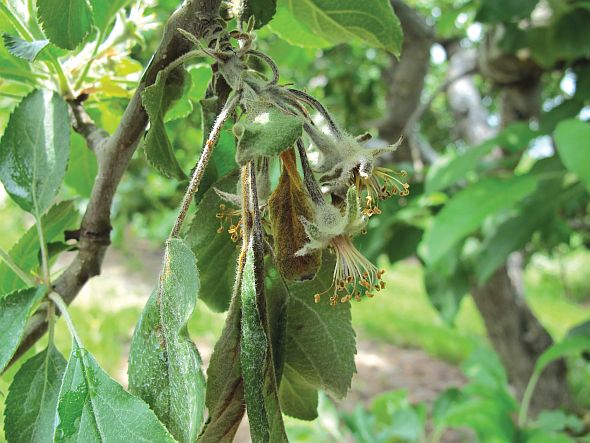How To Prevent Fire Blight
Fire blight is a disease most apple and pear growers are accustomed to dealing with. Prevention has become a commonplace part of tree fruit production.
However in Nova Scotia, the location of the 58th Annual International Fruit Tree Association conference, growers experienced more than a 90% infection rate last season due to a series of unfortunate events.
Fire blight has been a part of tree fruit growing in Nova Scotia for many years in pockets throughout the region, says Chris Duyvelshoff of Perennia, the Canadian provincial-crown Extension agency. But thanks to Hurricane Arthur, which hit the area the first week of July in 2014, inoculum was quickly spread throughout the Annapolis Valley growing region.
Duyvelshoff said there was some incidence of shoot blight before the storm. But, with wind gusts of 85 mph, inoculum was spread throughout the province. Fruit bruising and limbs snapped also as a result of these gusts.
“We were caught off guard at how quickly it could build. Just a few infections in some of these blocks resulted in a ton, just a few weeks later,” he says. “You have to be on top of it or it’s going to get you.”

Fire blight, here shown on an orchard in Michigan, can spread quite quickly when ooze cells are present. (Photo credit: George Sundin)
Inoculum Spreads Rapidly
George Sundin, a professor and Extension plant pathologist in the Plant, Soil, and Microbial Sciences Department at Michigan State University, indicated that this quick spread is due to “an invisible cloud of bacteria.”
“You can’t see it but there’s so much that they’re going to land everywhere,” he says. “If there are infections and ooze drops on the plant those ooze drops hold so much bacteria if they get spread around during a storm it’s a real problem.”
Duyvelshoff says growers in the area are a little spooked about adding new blocks of Gala, given its high susceptibility to fire blight. The variety took a hard hit during the epidemic of 2014.
What You Should Be Doing
Keeping in mind what happened in Nova Scotia, Duyvelshoff and Sundin offer some suggestions of what you can do to prevent the spread of fire blight in your orchard.
Start Early — Scout your orchard and prune out any cankers that might be present in the off-season. Apply copper as soon as trees break dormancy.
Follow Disease Forecast Models — Washington State University’s CougarBlight, or Maryblyt, are excellent resources for growers to monitor conditions conducive to fire blight.
“If we’re seeing 70 degree weather, if the risks are getting higher, then they have to start getting active and putting out streptomycin or Kasumin (Arysta LifeScience) particularly if the risk is moderate to high,” Sundin says. “If the risk is low to moderate then they can use oxytetracycline or Serenade (Bayer CropScience).”
Think About Resistance Prevention — Streptomycin should only be applied a maximum of three or four times a year at bloom, says Sundin. If the number of applications is limited and streptomycin is only applied during bloom, the risk of resistance development should remain very low.

Streptomycin should only be applied a maximum of three or four times a year at bloom, says Sundin. If the number of applications is limited and streptomycin is only applied during bloom to treat blossom blight. (Photo credit: George Sundin)
Sundin says some streptomycin resistance likely came from growers applying it to control shoot blight throughout the season.
Control Shoot Blight — Instead of using streptomycin, Apogee is the best defense against shoot blight, Sundin says.
“Apogee (BASF) is the best material we have for shoot blight management. It is a growth inhibitor and leads to shoot blight control and makes the cell walls of the plant thicker so the bacteria can’t infect them,” he says.
Apply Apogee at king bloom petal fall, and two more applications two weeks apart.
Make Sure Bud Material Is Clean — Duyvelshoff says he knows of one instance where fire blight was moved directly through contaminated grafting and budding material.
Be Ooze Wary — “Everybody’s got to be aware of what that is and not to even brush up against it because people can move those cells around too,” Sundin says.
The Arthur Aftermath
“It’ll take years to recover from some of the tree losses that happened this year in terms of young orchards getting ripped out, and losing a lot of fruiting wood,” says Duyvelshoff.
However, he is optimistic that the tree fruit industry, although hurting at the moment, will recover. Other places like Michigan have suffered losses, and recovered.
“(Growers in Michigan have) overcome fire blight but it’s just staying on top of it, being out there and looking for it, being diligent with the pruning, and using the tools,” he says. “If everybody does that, provided Mother Nature doesn’t throw us another curve ball, like it did this year, I think we’re in pretty good shape.”










